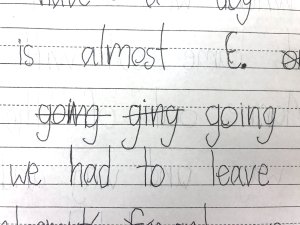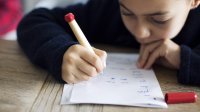A Simple Tool for Fostering Growth Mindset
You can have students use an old technology—ballpoint pens—to keep their mistakes and revisions, and their learning, visible.
Our second-grade team works hard to nurture a growth mindset in our students. We begin the year with morning messages about how our brains can grow and change. We read and discuss books about characters who learn from their mistakes. In our classroom makerspaces, we explicitly teach lessons on persistence and flexibility, and in math class our students work collaboratively to solve problems with multiple solutions or multiple paths to the solution.
Despite these efforts, there are still kids who hate to have a mistake on their paper. They will go to great lengths to eliminate any trace of an abandoned math strategy or the first attempt at an ending to a story. They will erase and erase, trying to make the paper clean again. Sometimes they erase so much that the friction from the eraser wears a hole right through the paper.
Rethinking Classroom Tools
As I watched my students at their tables writing and erasing with their pencils, I realized that the tools I was providing them no longer matched the work I was asking them to do. The pencils suggested that mistakes should be hidden and that there should be perfection in the product.
Pens, on the other hand, could help me teach my students to embrace the learning process and not be afraid to document the mistakes, revisions, and changes to their thinking they made along the way. So I gathered up all of the pencils from the table caddies and replaced them with pens.
At first, my students didn’t know how to use pens to do this work. In fact, in the absence of a pencil and eraser, some students just scribbled over their mistakes until they were illegible. I had to make time to explicitly teach them how to make changes with pens.

I now teach mini-lessons on drawing a single line through old thinking and on the different ways we can make room for new thinking. My students use carets, asterisks, and arrows to show where changes fit in. Our writing center has an ample supply of scrap paper and tape so they can create small flaps to tape over work when they want to edit or revise and there isn’t enough room on the page. My 7-year-old students are also very fond of cutting paper to extend the top, bottom, or sides of a page when more room is needed. It doesn’t always look pretty, but it does look like learning.
Now the tools in my classroom match the teaching. Instead of using pencils and erasers to hide their mistakes, my students use pens to document the effort they put into their work. In math, I teach them that the changes they make show evidence of flexibility and persistence as they try different strategies to solve problems successfully. I teach my students that, in their writing, revisions document their commitment to the craft of writing. They learn that even inked corrections to simple errors like miscalculations and misspellings provide evidence of attention to accuracy and detail.
Benefits for the Teacher
Making the switch to pens hasn’t just helped my students—I’m now a better-informed teacher. I can learn where to go next with my instruction by looking at what a student was attempting to do and where they spent time making changes. When a student abandons an open number line and draws base 10 blocks to successfully solve a math problem, I know they’re ready for more opportunities and support with open number lines. When a student attempts to spell a contraction multiple ways, I know this is a skill they’re eager to learn. Erased mistakes are missed opportunities for teachers.
I still have the pencils. They’re in the back of the room in the writing center and are used every once in a while for those special occasions when we don’t want to show all of the work that went on behind the scenes. My students might use pencils to write thank you letters to classroom visitors or descriptions of final projects that will be hung in the hall.
They understand that there’s a time and place for polished work to shine, but they also know the process of learning is something to be proud of. Their pen marks, arrows, and taped-on pieces of scrap paper make visible the hard work of growth and change.
